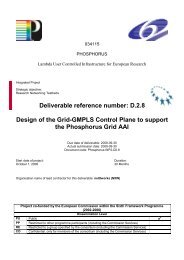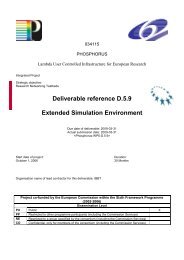Grid Job Routing Algorithms - Phosphorus
Grid Job Routing Algorithms - Phosphorus
Grid Job Routing Algorithms - Phosphorus
You also want an ePaper? Increase the reach of your titles
YUMPU automatically turns print PDFs into web optimized ePapers that Google loves.
<strong>Grid</strong> <strong>Job</strong> <strong>Routing</strong> <strong>Algorithms</strong>∑Ilcomm(44)Cl∈Epf ⋅ d + ≤ DThe set of candidate paths is reduced by discarding all paths with unacceptable total delay-cost value, and theRWA algorithm (as presented in Section 6.1.1) uses the remaining set of candidate paths.Bandwidth demandWe have considered an underlying WDM optical network that utilizes wavelength routing for establishingconnections. This approach poses limitations on the granularity of the bandwidth that can be assigned to aconnection request. One approach to provisioning fractional wavelength capacity is to multiplex traffic on awavelength. The resulting networks are referred to as WDM grooming networks [Zang02]. We won’t analysethese techniques further since they are out of the scope of this deliverable. However, with the algorithmspresented here we can address cases in which a connection demands bandwidth that is multiple of thecapacity of one wavelength (the user requires a connection with more than one wavelengths).In the RWA algorithms (presented in this Deliverable) we give as input a n× n traffic matrix of integers denotedas R, whose elements represent the requested connections, e.g. R sd =m means that from (source) node s to(destination) node d there is a request that demands m (m ≥ 1) number of wavelengths.There are two possible solutions to the demand of more than one wavelength (m>1):(i)(ii)The LP formulation (Section 6.1.1 and Appendix A) solve this RWA problem so that thedemanded m wavelengths can be routed by j different paths and j m , where k is the≤ , j ≤ knumber of candidate paths examined for each connection (used in the Dijkstra k-shortest pathalgorithm).If there is a demand that the m (m>1) wavelengths of the requested connection have to be routedover the same path, then we have to modify the LP formulation presented in Appendix A. Thechanges are presented in Appendix B.Delay jitter requirementThis user QoS requirement is not applicable to the kind of networks that we are examining. Delay jitter can bemeasured in packet switched networks where the buffering delays and routing decisions affect the delay andpossible the order in which the packets arrive at the destination. However, in the networks discussed here, anend-to-end circuit switched connection is established in a form of a wavelength switched path over a WDMnetwork. Therefore, assuming that the RWA solution gives a feasible solution to the connection request, anyDelay jitter requirement of a <strong>Grid</strong> user can be met by this connection.Packet loss ratioA <strong>Grid</strong> user might request that his connection has packet loss ratio which is less than an upper bound. In ouralgorithms, we have expressed and ensured the quality of the end-to-end wavelength connection throughProject:PHOSPHORUSDeliverable Number: D.5.3Date of Issue: 31/06/07EC Contract No.: 034115Document Code: <strong>Phosphorus</strong>-WP5-D5.376






